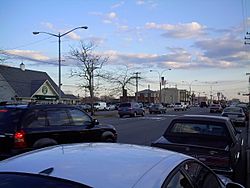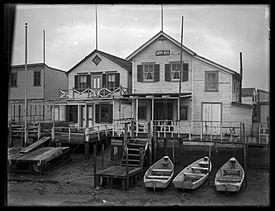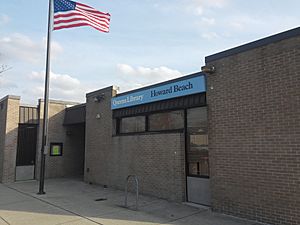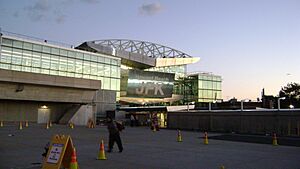Howard Beach facts for kids
Quick facts for kids
Howard Beach
|
|
|---|---|
|
Neighborhood in Queens
|
|
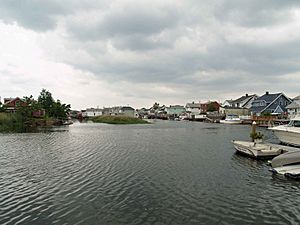
Homes on Hawtree Creek
|
|
| Country | |
| State | |
| City | |
| County/Borough | |
| Community District | Queens 10 |
| Named for | William J. Howard |
| Population
(2010)
|
|
| • Total | 26,148 |
| Economics | |
| • Median income | $91,175 |
| Time zone | UTC−5 (EST) |
| • Summer (DST) | UTC−4 (EDT) |
| ZIP Code |
11414
|
| Area codes | 718, 347, 929, and 917 |
Howard Beach is a neighborhood located in the southwestern part of Queens, a borough of New York City. It is surrounded by different areas: Ozone Park to the north, Jamaica Bay to the south, South Ozone Park to the east, and East New York, Brooklyn to the west. This neighborhood is mostly made up of small, single-family houses.
Howard Beach is part of Queens Community District 10. Its ZIP Code is 11414. The New York City Police Department's 106th Precinct keeps the area safe. For local government, Howard Beach is part of the 32nd District of the New York City Council.
Contents
Exploring the History of Howard Beach
How Howard Beach Began
Howard Beach was started in 1897 by William J. Howard. He was a glove maker from Brooklyn. He owned a large goat farm near Aqueduct Racetrack. In 1897, he bought more land and filled it in. The next year, he built 18 small houses and opened a hotel near the water. This hotel burned down in 1907.
William Howard kept buying land and formed the Howard Estates Development Company in 1909. He worked to fill in the land, gathering 500 acres by 1914. He planned streets, water pipes, and gas lines. He also built 35 houses, which sold for $2,500 to $5,000.
The Long Island Rail Road (LIRR) opened a station called Ramblersville in 1905. A Post Office with the same name opened soon after. In 1915, a casino, beach, and fishing pier were added. On April 6, 1916, the neighborhood's name officially changed to Howard Beach.
More development happened, and investors began selling land lots for about $690 each in 1922. However, building was mostly limited to the area east of Cross Bay Boulevard, near the LIRR station. This station is now called Bernard Coleman Memorial Square. The rest of Howard Beach was empty marshland. The area south of Coleman Square, around Russell and 102nd Streets, had many small fishing bungalows. This part of Howard Beach kept the name Ramblersville. In 1919, the LIRR opened the Hamilton Beach station, a bit south of the Howard Beach station.
Growth After World War II
After World War II, Queens and Long Island saw a big building boom. The marshland west of Cross Bay Boulevard was filled in. This allowed for many Cape Cod and High Ranch-style homes to be built. This new area was called Rockwood Park in the north and Spring Park in the south. Together, they became known as New Howard Beach. The area east of the boulevard was then called Old Howard Beach.
In the early 1950s, farmland north of Rockwood Park was developed. New buildings included red-brick, two-story apartments and taller co-op and condo buildings. This new area was named Lindenwood. Building continued through the 1960s and 1970s. Cross Bay Boulevard became the main shopping area.
Hurricane Sandy's Impact
When Hurricane Sandy was coming in October 2012, city officials told people in certain areas, like Hamilton Beach, to leave their homes. Most of Howard Beach was in a zone where leaving was optional. Many people stayed, remembering that Hurricane Irene the year before had not caused much damage.
On October 29, Sandy hit. A ten-foot storm surge from Jamaica Bay flooded many parts of Howard Beach. Homes, businesses along Cross Bay Boulevard, the Howard Beach–JFK Airport subway station, and the train tracks over Jamaica Bay were all badly damaged. Many homes lost power for up to three weeks.
After Sandy, the Federal Emergency Management Agency (FEMA) and the New York City Office of Emergency Management changed the flood zone maps. Howard Beach was then put into a higher-risk zone. The Howard Beach post office, which was heavily damaged, reopened in April 2013 after many repairs.
Geography and Local Areas
Howard Beach is made up of several smaller neighborhoods. These include Howard Beach, Old Howard Beach, Hamilton Beach, Ramblersville, Spring Park, Rockwood Park, Lindenwood, and Howard Park. Sometimes, Old Howard Beach, Ramblersville, Howard Park, and Hamilton Beach are all called "Old Howard Beach."
The main part of Howard Beach is a small piece of land surrounded by water. It has the Belt Parkway to the north and Jamaica Bay to the south. Hawtree Creek is to the east, and Shellbank Basin is to the west.
Cross Bay Boulevard is the main shopping street in Howard Beach. In the past, it had many local shops and restaurants. Since the 1990s, more chain stores have opened there. The Joseph P. Addabbo Memorial Bridge carries Cross Bay Boulevard over Jamaica Bay. This bridge connects mainland Queens to Broad Channel.
Bernard Coleman Memorial Square is a small park near the Howard Beach – JFK Airport station. It has a memorial for soldiers from Howard Beach who died in World War I, World War II, the Korean War, and the Vietnam War.
Hamilton Beach: A Unique Community
Hamilton Beach is bordered by the 102nd Street Creek to the north and Jamaica Bay to the south. JFK Airport is to the east, and Hawtree Creek is to the west. Before it became part of the city, Hamilton Beach had dirt roads and small bungalow homes. It also did not have a sewer system. Hamilton Beach is special because it has its own volunteer fire department.
Until 1955, Hamilton Beach had a train station on the LIRR. The station closed when the train line was sold to the New York City Transit Authority. The community has one main road, 104th Street, with ten dead-end blocks. It is mostly surrounded by water. You can enter by car or by two walking paths. One path is a boardwalk from the Howard Beach-JFK Airport station. The other is a pedestrian bridge connecting to Old Howard Beach.
Hamilton Beach has a small park at its southern end. It includes a baseball field, a handball court, a jungle gym, and a beach. Gateways Hamilton Beach Park is the last stop for the Q11 bus. More houses have been built in the area since the early 2000s.
Lindenwood: A Planned Neighborhood
Lindenwood is a part of Howard Beach that was built in the 1950s and 1960s on filled-in land. It is considered part of New Howard Beach. The neighborhood has six-story apartment buildings and smaller "garden apartments." There are also two-family homes. Many apartment buildings are co-ops or condominiums.
At the center of Lindenwood is P.S. 232, now called the Walter Ward School. It is named after a local City Councilman. The Lindenwood Shopping Center has a supermarket and about 20 stores. Another small shopping area is on Linden Boulevard.
Old Howard Beach: The Original Area
Old Howard Beach is the part of Howard Beach located east of Cross Bay Boulevard. It is between Shellbank Basin and Hawtree Creek. Coleman Square and Frank M. Charles Park are in Old Howard Beach. This area is called "Old Howard Beach" because it's where William Howard first built his hotel and the neighborhood's first houses in the 1920s.
The houses in Old Howard Beach vary. Near the former Howard Beach General Hospital, there are mainly two-family homes from the 1950s and 1960s. Near Coleman Square and Frank M. Charles Park, there are mostly single-family homes. The Q11 bus serves this neighborhood.
Ramblersville: A Historic Fishing Village
Ramblersville is a small neighborhood of about a dozen blocks. It is almost surrounded by waterways that lead into Jamaica Bay. It is bordered by 160th Avenue to the north and JFK Airport to the east. Hawtree Creek is to the west, and 102nd Street Creek is to the south.
Ramblersville is thought to be the oldest neighborhood in what became Howard Beach. In 1905, a newspaper article said the houses were built on stilts. It also said about 1,000 people lived there in the summer, but only a dozen in the winter. In 1962, the city replaced the water pipes. At that time, about 130 families lived there.
Fishing was a very important job in Ramblersville. In 2001, The New York Times newspaper said Ramblersville felt like a fishing village. It had pebbled streets and wooden bungalows built on tall posts, surrounded by tall grass.
Before 1916, the entire area now called Howard Beach was often known as Ramblersville. This included Hamilton Beach and Old Howard Beach. The Howard Beach – JFK Airport station was originally called Ramblersville Station. Ramblersville is the smallest neighborhood in New York City based on land size.
Rockwood Park: Modern Homes and Famous Residents
Rockwood Park mainly has single-family houses. Locals sometimes call it "New Howard." It is located between 78th and 92nd Streets (north-south) and 156th and 165th Avenues (east-west). The Q41 and Q21 bus routes provide public transportation. To the west of 78th Street is Spring Creek Park, which is the border between Brooklyn and Queens.
This area was undeveloped until after World War II. Then, the marshland was filled in, and Cape Cod-style houses were built. In the 1960s and 1970s, high ranch-style houses were added. The area became known for nice homes. Famous people have lived here, including folk singer Woody Guthrie.
Population and Community Life
Based on the 2010 United States census, Howard Beach had 26,148 people. This was a small decrease from 2000. The neighborhood covers about 1,471 acres. Most residents are White (76.8%), with smaller numbers of African American (1.6%), Asian (3.5%), and Hispanic or Latino (16.8%) people. As of 2022, about half of the people living here are of Italian descent.
The average life expectancy in Howard Beach and nearby areas is 81.7 years. Most people are young or middle-aged adults. About 19% of residents live in poverty, which is similar to the rest of Queens and New York City. About 10% of people are unemployed. Many residents (56%) have trouble paying their rent. Howard Beach is considered a high-income area compared to the rest of the city.
Fire Safety Services
Howard Beach has a New York City Fire Department (FDNY) fire station, Engine Co. 331/Ladder Co. 173. It is located at 158-99 Cross Bay Boulevard.
Hamilton Beach has its own volunteer fire department, called the West Hamilton Beach Volunteer Fire Department. They have several fire engines and ambulances.
Mail Services and ZIP Code
Howard Beach uses the ZIP Code 11414. The United States Postal Service has two post offices nearby. One is Station A at 160-50 Cross Bay Boulevard. The other is Station B at 102-12 159th Avenue.
Education in Howard Beach
Howard Beach and South Ozone Park generally have fewer college-educated residents than other parts of New York City. About 28% of adults aged 25 and older have a college degree or higher. However, 23% have less than a high school education.
Students in Howard Beach and South Ozone Park are doing better in school. The number of students doing well in math increased from 33% in 2000 to 61% in 2011. Reading achievement also improved from 37% to 48% in the same period.
Fewer elementary school students in Howard Beach and South Ozone Park miss many days of school. Only 18% miss twenty or more days, which is lower than the city average. Also, 82% of high school students graduate on time, which is higher than the city average.
Schools in the Area
- PS 146 The Howard Beach School
- PS 207 The Rockwood Park School
- PS 232 The Walter Ward School
- St. Helens Catholic School (K–8)
Before, students from PS 207, PS 232, or PS 146 would go to Junior High School 202 (Robert H. Goddard Junior High School) for grades 7–8. A footbridge helps students from southern Howard Beach get to the school.
For high school (grades 9–12), students could attend John Adams High School in nearby Ozone Park. Some also went to special high schools or Catholic high schools. In July 2020, Our Lady of Grace Catholic School closed.
Local Library
The Queens Public Library has a branch in Howard Beach. It is located at 92-06 156th Avenue.
Getting Around: Transportation
The New York City Subway's Howard Beach–JFK Airport station is on the IND Rockaway Line. This station used to be a Long Island Rail Road station. Frequent fires on the trestle (a bridge with a framework) to Broad Channel caused the LIRR to sell the line in the 1950s. The station connects the subway to the Howard Beach JFK AirTrain route. The AirTrain takes people to JFK Airport. Before the AirTrain, a free shuttle bus took people to the airport.
Local bus service in the neighborhood is provided by the Q11, Q21, Q41, Q52 SBS, Q53 SBS routes. These buses are run by the MTA Bus Company. There are also express buses: QM15, QM16, QM17.
Well-Known People from Howard Beach
Many interesting people have lived in Howard Beach, including:
- Vito Antuofermo (born 1953), a former boxer and actor.
- Marco Battaglia (born 1973), a former American football player.
- DJ Skribble (born 1968), a DJ, producer, and TV personality.
- Vitas Gerulaitis (1954–1994), a professional tennis player.
- Keith Gottfried (born 1966), who worked for the U.S. government.
- Woody Guthrie (1912–1967), a famous folk music singer.
- Rick Hearst (born 1965), a soap-opera actor.
- James Maritato (born 1972), a professional wrestler.
- George Martin (born 1953), a football player for the New York Giants.
- Joey Ramone (1951–2001) and his brother Mickey Leigh (born 1954), who lived in Howard Beach as children.
- Pia Toscano (born 1988), a singer from American Idol.
- John T. Braton, LtCol, served in the US Marine Corps from 1962 to 1987; a decorated Vietnam veteran born and raised in Old Howard Beach. As a USMC F4 Phantom fighter pilot flew over 500 missions over Vietnam in two tours of duty, earning the Distinguished Flying Cross and Air Medals.
See also
 In Spanish: Howard Beach (Queens) para niños
In Spanish: Howard Beach (Queens) para niños



